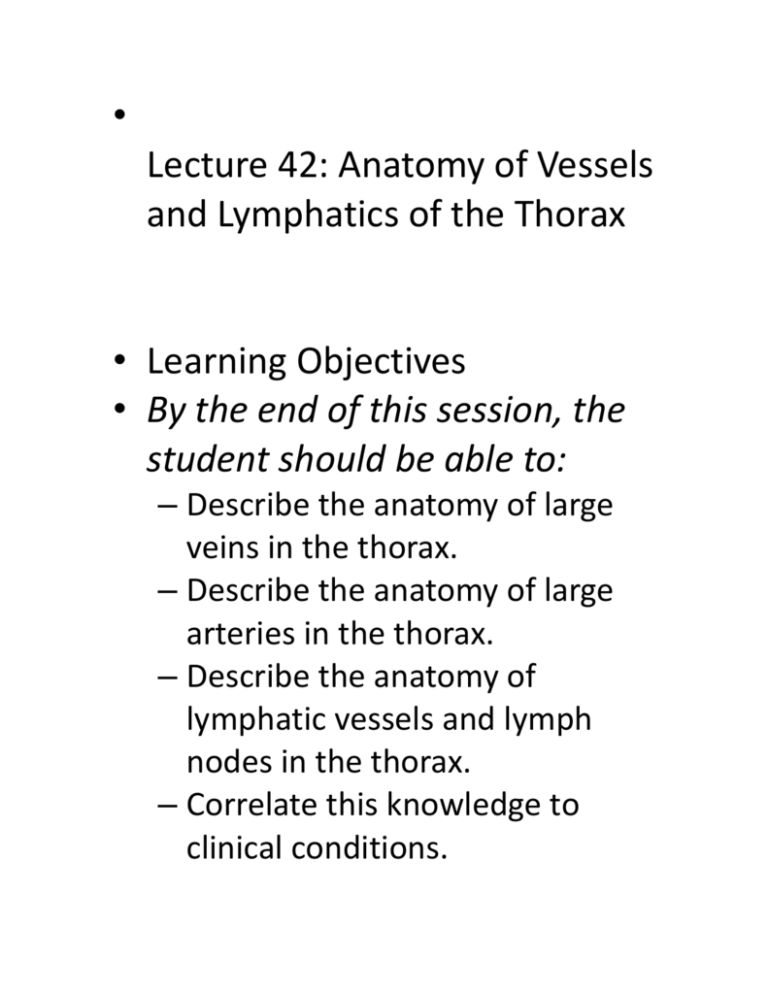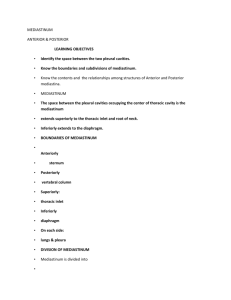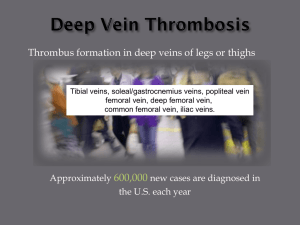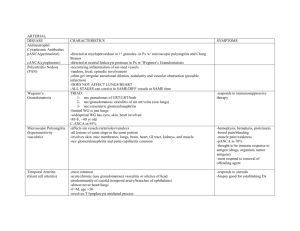Azygos vein
advertisement

• Lecture 42: Anatomy of Vessels and Lymphatics of the Thorax • Learning Objectives • By the end of this session, the student should be able to: – Describe the anatomy of large veins in the thorax. – Describe the anatomy of large arteries in the thorax. – Describe the anatomy of lymphatic vessels and lymph nodes in the thorax. – Correlate this knowledge to clinical conditions. • Reference: Clinical Anatomy by Regions: R.S. Snell, 9th ed., Ch. 3, P. 93-99. • Large veins of the thorax • Right brachiocephalic vein is formed at the root of the neck by the union of the right subclavian and the right internal jugular veins. • Left brachiocephalic vein has a similar origin . It passes obliquely downward and to the right behind the manubrium sterni and in front of the large branches of the aortic arch. It joins the right brachiocephalic vein to form the superior vena cava. • Superior Vena Cava: contains all the venous blood from the head and neck and both upper limbs and is formed by the union of the two brachiocephalic veins. It passes downward to end in the right atrium of the heart. The vena azygos joins the posterior aspect of the superior vena cava just before it enters the pericardium. • Azygos system of veins: – Main azygos vein – Inferior hemiazygos vein – Superior hemiazygos vein. • Drain blood from posterior parts of intercostal spaces, posterior abdominal wall, pericardium, diaphragm, bronchi, and the esophagus. • Azygos vein: Often formed by union of right ascending lumbar vein and right subcostal vein and empties into the posterior surface of the superior vena cava. • Inferior Hemiazygos vein: Often formed by union of left ascending lumbar vein and left subcostal vein and joins azygos veins. • Superior Hemiazygos vein: Formed by the union of 4th-8th intercostal veins, joins azygos vein at the level of 7th thoracic vertebra. • Inferior Vena Cava: pierces the central tendon of diaphragm opposite 8th thoracic vertebra and almost immediately enters lowest part of the right atrium. • Large arteries of the thorax • Aorta: Main arterial trunk, is divided for purposes of description into: – ascending aorta, – arch of the aorta, – descending thoracic aorta – abdominal aorta. • Ascending aorta: Begins at base of left ventricle ,runs upward and forward to come to lie behind right half of the sternum at sternal angle level, where it becomes continuous with arch of aorta. • Arch of the Aorta: A continuation of the ascending aorta, lies behind manubrium sterni and becomes continuous with the descending aorta at the level of sternal angle. • Branches: – Brachiocephalic artery, left and right common carotid arteries. • Descending Thoracic Aorta: lies in the posterior mediastinum and begins as continuation of arch of aorta on the left side of the lower border of the body of T4 vertebra. • Abdominal aorta • Pumonary trunk: – Conveys deoxygenated blood from right ventricle of the heart to the lungs. – Right and left pulmonary arteries • Lymphatics of thorax • Thoracic wall: • Superficial: – anterior thoracic wall →anterior axillary nodes – Posterior thoracic wall→ posterior nodes • Deep: – Anterior parts→Internal thoracic nodes→ thoracic duct(left side), bronchomediastinal trunk (right side). – Posterior parts→ posterior intercostal nodes → thoracic duct. • Mediastinum: the scattered lymph nodes in lungs and mediatinum drain the lymph to bronchomediastinal trunk and thoracic duct. • Thoracic duct: – Begins as cisterna chyli in the abdomen. – Ascends through the aortic opening of diaphragm – Enters the left brachiocephalic vein – Drains the lymph from whole of the field below the diaphragm, and the left side of the body above while the right side of the body is drained by right lymphatic duct (in right brachiocephalic vein) • Clinical Correlates • Azygos Veins and Caval Obstruction: In obstruction of the superior or inferior venae cavae, the azygos veins provide an alternative pathway for the return of venous blood to the right atrium of the heart. This is possible because these veins and their tributaries connect the superior and inferior venae cavae. • Clinical Correlates-Contd • Coarctation of the aorta: A congenital narrowing of the aorta just proximal, opposite, or distal to the site of attachment of the ligamentum arteriosum. • Clinically, the cardinal sign of aortic coarctation is absent or diminished pulses in the femoral arteries of both lower limbs. To compensate for the diminished volume of blood reaching the lower part of the body, an enormous collateral circulation develops, with dilatation of the internal thoracic, subclavian, and posterior intercostal arteries. The dilated intercostal arteries erode the lower borders of the ribs, producing characteristic notching, which is seen on radiographic examination.







